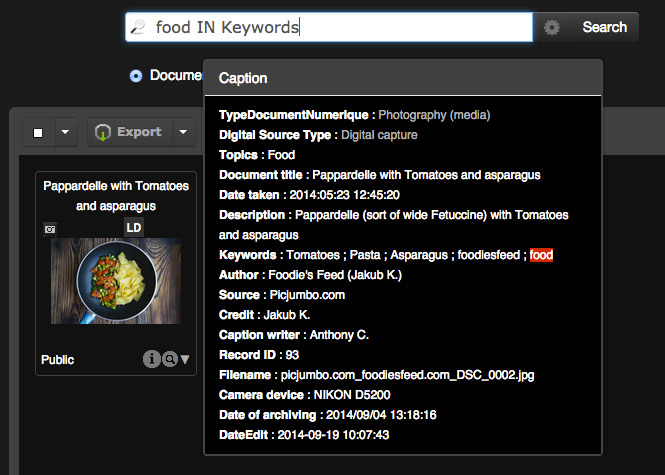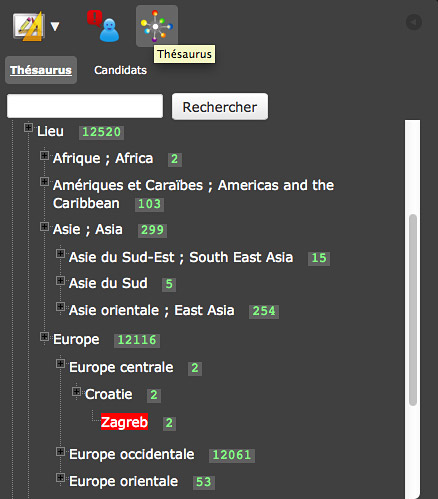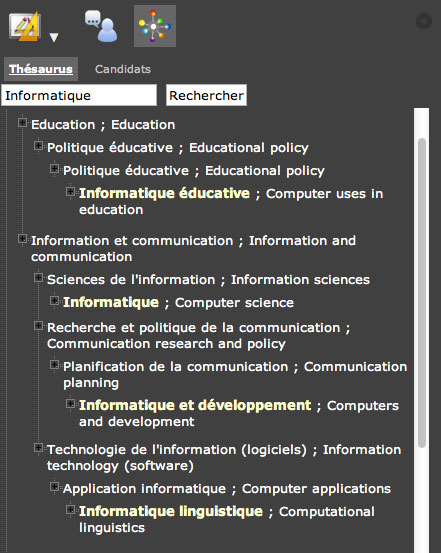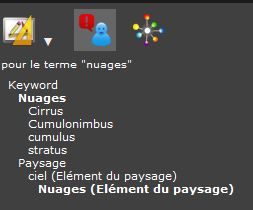Search for records¶
The essential
The media and stories searches in Phraseanet are made through a full text search engine that works like many search engines.
Combined with common search operators, these searches are more relevant. Extended searches can be made with other less used operators. It is also possible to search in specific fields if needed.
If a Thesaurus is activated, the search and review of the results can be greatly enhanced.
Remember that in most case, indexation quality remains the dominant factor in search results.
Full text search¶
Phraseanet suggests by default a full text search that allows to display media depending on the information contained in the documentary fields of their descriptive note.
By default, the search apply on Phraseanet bases and collections documents accessible by the user. The displayed records are the result of a customizable initial question.

To search stories, place the radio-button of the search mode in the story position. In this mode, the search is on the content of the stories note.
Note
Simultaneous searches on documents and stories are not possible.
To search :
- Type the term(s) to look for in the search form
- Click on the Search button
The search engine is not case sensitive and do not distinguish accented characters from others.
The results are displayed in the display area. The relevance depends on the indexation quality of the media and the search query.
Note
The number of results per page is customizable. Refer to the page Customize the interface for more information.
Boolean operators and wildcards¶
By default, the operator between two terms is the boolean operator AND. Therefore it’s not necessary to type it. All the terms typed in the form are in the descriptive notes of the displayed media.
Other common operators are available:
- The operator OR allows to look alternatively for several terms in the media notes. For example, if the search is sea or mountain, the descriptive notes of the displayed media will contain either the word sea, or the word mountain, or both.
- The operator EXCEPT allows to exclude a term from the search. If the search is on beaches not in France, type beach EXCEPT France.
- The operator * is a wildcard. It allows to truncate the characters on the right of the searched term : a search like natur* displays the media which descriptive notes contain the words starting with “natur” like nature, natures ... etc.
- The search between double quotes is possible : it allows to search for contiguous terms or exact match expression in the media descriptive notes.
Other options exists using advanced operators.
Specific operators¶
Phraseanet has other specific operators:
- All, to search all the documents of the selected Phraseanet bases or collections.
- Last ( with or without specifying a number) displays by default the 12 last documents added by Phraseanet base in the selected collections. Combined with an integer, the n last documents will be displayed.
In a Last 100 search with 3 opened Phraseanet bases/collection, the number of displayed media can be up to 300 (3 times the last 100 added media), considering the number of documents for each base or collection is more than 100
Search in a specific field¶
It is possible to limit the search to a field of the description. The search pattern is the term searched IN a specific field.
A search London in City will display the documents that contain the term London in a field named City.
A search France in Country will display the documents that contain the term France in the field named Country.

Note
For a field search, be sure to use the field name as stated in the documentary structure. Field names are case sensitive.
Advanced search¶
To display the advanced search form, click on the geared wheel between the search field and the button Search.

The window of advanced search is in three parts:
- The search form
- The list of available bases and collections
- The list of search filters
Check or uncheck the Phraseanet bases and collections to search in.
It is possible to un-select all the Phraseanet bases and collections. Click on “None” or on each label of the bases to select or deselect them.
Note
If no collection is selected, then the search apply on all Phraseanet bases and collections available to user.
The available filters allow to narrow the search results:
- Activate or de-activate the search by Stemm
- Search one or more specific fields
- Filter by status
- Limit the searches with periods
The options of the advanced search stay. The choices used in the advanced search window are kept as long as they are not modified. If there are search options, the form background will be yellow.
Search using the Thesaurus¶
If a Thesaurus is activated, the search and the results review can be greatly enhanced.
Display the Thesaurus¶
The search using the Thesaurus is launched from the Thesaurus tab of the work area.

It presents a tree of the deployed thesaurus where the nodes and terms are clickable.
- Click on the “+” of the nodes to deploy them and browse through the terms it contains.
- Double click on a term to start searching.
A search in the thesaurus terms is possible using a form. Include at least the first three characters of a term to trigger the auto-completion system.

Use the proposals¶
The proposals tab displays suggestions related to the user search and the terms contained in the thesaurus of the searched bases.
By going up the terms in Thesaurus, the user is advised to specify its research or to widen it to a larger cognitive scope with suggested terms.
Each proposal is clickable and allows to launch a new Thesaurus search.

Note
The relevance of the proposals in this tab are linked to the construction of the deployed thesaurus.
